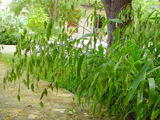Native Plants

Q. Who is Mr. Smarty Plants?
A: There are those who suspect Wildflower Center volunteers are the culpable and capable culprits. Yet, others think staff members play some, albeit small, role. You can torture us with your plant questions, but we will never reveal the Green Guru's secret identity.
Did you know you can access the Native Plant Information Network with your web-enabled smartphone?
Ask Mr. Smarty Plants is a free service provided by the staff and volunteers at the Lady Bird Johnson Wildflower Center.

rate this answer
Saturday - August 09, 2008
From: Houston, TX
Region: Southwest
Topic: Erosion Control
Title: Erosion control for slope to detention pond
Answered by: Nan Hampton
QUESTION:
We have been required by code to build a detention pond for new church buildings in the Webster, TX (Clear Lake) area. There is a serious erosion of soil from water runoff from the building roof needing immediate attention to stabilize the slope, then plant native turf grasses. The distance between the building and the pond rim is about 14' maximum. Seeking advice on erosion control matting and choice of seed or sod grasses.ANSWER:
Here is information about using erosion-control blankets and/or fiber or coir rolls to stabilize the erosion area. The fiber rolls and erosion-control fabric work by slowing the runoff water and allowing sediment to fall out rather than be washed away. Seeds are sown under the erosion-control material and grow up through the matting when they germinate. Underneath the matting the roots of the plants growing through the erosion-control material anchor the soil to stop the erosion. If you use erosion-control blankets made of biodegrable material, they will eventually disappear leaving the plants to control the problem.
Native grasses are an excellent choice for controlling erosion because they develop extensive fibrous root systems that hold the soil in place. Seeds can be sown under an erosion control blanket or grass plugs can be planted through the blanket. After the grasses have begun to establish themselves and stabilize the area you can add other plants. On the pond edge you could consider adding some attractive aquatic plants to help with the erosion.
Native American Seed in Junction, Texas has a turf grass mix that is 34% Bouteloua gracilis (blue grama) and 66% Bouteloua dactyloides (buffalograss). This grass mixture requires little or no mowing (maximum height is 5 to 8 inches) and will not require extra watering once established. It does best in full sun but will tolerate some shade.
Another possibility for a native turf grass is Muhlenbergia schreberi (nimblewill). It is a fine feathery grass that looks similar to bermuda grass. Please see the answer to a previous question discussing nimblewill.
Here are a few plants that would do well around the detention pond:
Chasmanthium latifolium (Inland sea oats)
Andropogon glomeratus (bushy bluestem)
Lobelia cardinalis (cardinalflower)
From the Image Gallery
More Erosion Control Questions
Plants to prevent riverbank erosion in NY
October 03, 2010 - Dear Mr. Smarty Plants,
I'm doing research into riverbank erosion in Broome County, NY, and I was wondering if you had some sort of resource that would be able to tell me which species of grasses...
view the full question and answer
Landscaping recommendations for site in Dubuque, IA
March 27, 2010 - I need a seed recommendation. Here are the variables:
Location: Dubuque, IA (east Central Iowa)
Soil type: Sandy to sandy and gravelly. Part is a riverbank facing east. Steep bank then flat to ...
view the full question and answer
Plants to hold a slope in Northern New York
December 10, 2009 - I'm looking for native (South shore, Lake Ontario) plants to slow erosion on a steep, 20 foot bank. They don't have to be decorative (although flowering plants are always nice), but they should SPRE...
view the full question and answer
Construction problems on site in Mansfield OH
April 28, 2012 - Last year we had a rectangular above ground pool put in the person who "leveled" for use did a terrible job and basically dug a huge hole for us to put our pool in. The back side of the pool is abou...
view the full question and answer
Native plants to stabilize a steep bank in Pennsylvania
April 23, 2008 - I would like to use native plantings to stabilize a steep bank of a septic leach field in eastern Pennsylvania. My purpose is to control erosion and to eliminate the need for mowing. What would you r...
view the full question and answer
| Support the Wildflower Center by Donating Online or Becoming a Member today. |

